Month: June 2020
“Images enlarge the space, expand it – form tunnels into other worlds,
make the room a Charles de Gaulle departure hall”
Karl-Heinz Schwind
Karl-Heinz Schwind (*1958 in Landau) studied under Georg Baselitz from 1978-84 and was a master student of Per Kirkeby at the Karlsruhe Art Academy from 1984-85.
His colorful, strong works, some of which border on material battles, contain numerous quotes from art history. Schwind tries it out – that’s his style. His works show the political and cultural tensions of West Germany in the 80s. He finds endless inspiration in his surroundings: people, commuters, Berlin tourists, the community. And Milva’s music.
To question himself and society – this is what Schwind has been working on in his painting to this day. He is not afraid of references, thematically he incorporates Ludwig Kirchner into his works, just as quotes of Dadaism and technical transformation of Tachism.
He follows an inspiration almost archaically, anarchically and creates work out of what falls into his hands: wood, magazines, wax crayons, canvas, yarn.
Schwind lives and works in Berlin.
From the catalogue of the first exhibition by Daniel Blau, Munich 1990: “Images enlarge the space, expand it – form tunnels into other worlds, make the room a Charles de Gaulle departure hall”.
All photographs are available for purchase. Prices upon request. For further information please send an email to: contact@danielblau.com
All offers are noncommital. We cannot guarantee the items are still available on request.
Other Diversions
Albertina - Die frühe Radierung. Von Dürer bis Bruegel Staatliche Museen Berlin - Raffael in Berlin. Meisterwerke aus dem Kupferstichkabinett Kunstgewerbe Berlin Music video by Milva performing Freiheit in meiner Sprache (Official Video). (C) 1999 Sony Music

Grapes Lost and Found
Exhibition:
June 17 – July 21, 2020
11am – 6pm | mon – fri
Maximilianstraße 26, 80539 München
In a recent conversation I had with Billy Al Bengston (Link to Bio), he quoted his racing buddy: “If it only costs money, it’s cheap.” Being an avid collector myself (although not of Contemporary Art) my interpretation of his words is: It can take a lot of effort, time and money to track down a specific object. Sometimes it can take years and money can’t help.
We had an exhibition of large Lüpertz (Link to Bio) paintings from 1967-70 at Art Basel in 2005. The paintings were huge. The show looked stunning and was a great success. The painting “Weintrauben” did not find a place in the show of tree trunks, telegraph poles and tunnels and remained upstairs in storage to return with the other works to Germany after the fair. But it never arrived. We only realised it had gone missing about a year later when a loan request for the work came and we couldn’t locate it.
Now 15 years later a friend sends me this cryptic text message: “Dear Daniel, tell me, are you missing a grape painting? I hope you are well. Best wishes…”
It turns out that the crate with our label still on it mysteriously turned up in a private furniture warehouse in Munich. The owner of that warehouse is a friend of our friend. I thought “Great! The grapes are back.” But then the finder emailed: “How can I be sure you are the owner? I think I’d better go to the police.” Days of silence followed. The painting had vanished again. Then somebody within the city’s Lost and Found department called up. He had been referred to us by the Lenbachhaus, and wondered if we dealt in Lüpertz? “There is this painting someone found…”
I am sure that many of the artworks we enjoy today would have fascinating stories to tell, if only they could speak to us in words as well as with their beauty. I thought this lucky moment merited a presentation on the theme of flora and color.
Karl-Heinz Schwind (Link to Bio) was our first exhibition when we opened some 30 years ago. His works are pure energy.
Eugène Leroy (Link to Bio), who sometimes worked for several years on a painting before considering it finished, Don van Vliet, cult musician and painter and Billy Al Bengston, known for his tropical themes and vivid colors, are well known and do not need my introduction.
David Byrd is neither “Insider” nor “Outsider”. Having studied art after WWII under Amédée Ozenfant he only developed his mature style and produced his most defining body of work after he started working as an orderly at a hospital psychiatric ward, from 1958-88.
His paintings defy any of the “Isms” we usually like to apply to art we see; they stand apart from Pop, Realism or Expressionism. If anything I would refer to his work as New York Surrealism. Byrd’s works have an airy and somewhat evanescent quality, as if viewed through a milky glass.
Guerle and Nény were true self-taught artists who remained more or less in obscurity but whose visual languages are equally inspiring and distinctive as the better-known artists in our exhibition. They only came to my attention through writers like Hans Prinzhorn or Dr. Jean Lacassagne, who were interested in and propagated the artistic output of mentally insane or criminal individuals. Prinzhorn’s Bildnerei der Geisteskranken (Berlin 1922) and Albums du Crocodile by Lacassagne (Lyon 1939) have been rare sources of information on these fascinating artists.

Karl-Heinz Schwind(*1958 in Landau)
From the catalogue of the first exhibition by Daniel Blau, Munich 1990: “Images enlarge the space, expand it – form tunnels into other worlds, make the room a Charles de Gaulle departure hall”
Karl-Heinz Schwind studied under Georg Baselitz from 1978-84 and was a master student of Per Kirkeby at the Karlsruhe Art Academy from 1984-85.
His colourful, strong works, some of which border on material battles, contain numerous quotes from art history.
Schwind tries it out – that’s his style. His works show the political and cultural tensions of West Germany in the 80s.
To question himself and society – this is what Schwind has been working on in his painting to this day. He is not afraid of references, thematically he incorporates Ludwig Kirchner into his works, just as quotes of Dadaism and technical transformation of Tachism.
He follows an inspiration almost archaically, anarchically and creates work out of what falls into his hands: wood, magazines, wax crayons, canvas, yarn.
Schwind lives and works in Berlin.

Billy Al Bengston (*1934 in Dodge City, Kansas)
is an American artist and sculptor. Bengston’s fondness for motorcycles influences his artworks, which often consist of vibrant lacquer on metal.
He also works on paper and canvas. Besides motorcycle culture, surfing and his life in California and Hawaii give the artist’s works their character.
In 1955 he went to California College of Arts in Oakland followed by studies at Otis Art Institute in LA. Since 1958 there have been various solo exhibitions in LA with Ferus Gallery. His first solo museum exhibition was in 1968 at LACMA. The 1960s were shaped by professional motorcycle racing. In 1974 he visited Hawaii for the first time.
Bengston surfs and paints in Venice Beach and Honolulu.
Exhibitions and Distinctions (Selection)
2018
“Endless Summer”, Museum of Contemporary Art Chicago, USA
2017
“California Dreaming: Ed Moses, Billy Al Bengston, Ed Ruscha”, New Britain Museum of American Art, USA
2016
“Still Life with Fish: Photography from the Collection”, Hammer Museum, Los Angeles, USA “Los Angeles, – a Fiction”, Astrup Fearnley Museet, Oslo, Norway
2015
“Drawing in L.A.: The 1960s and 70s”, Los Angeles County Museum of Art, USA
2014
“Selections from the Permanent Collection”, Museum of Contemporary Art, Los Angeles, USA
2013
“Craig Turned On The Light and California Art Bloomed”, Honolulu Museum of Art, Hawaii.
2012
“Sinister Pop”, Whitney Museum of American Art, New York, USA

There are just a few examples of the ways in which artists have turned
their attention to cars and car cultur
auto – Mobile
Cars, steam engines, aircraft and space ships proved endlessly inspiring to early and modern photographers and artists, who documented the new vehicles and the journeys they enabled. A new kind of landscape photography emerged, situating man and his machines in the context of rural, urban, or extraterrestrial terrains.
Consider Franklin Price Knott’s ‘Automobile in Italy’ (c. 1910), Hugo Adolf Bernatzik’s ‘Autopanne’, (1927) or NASA’s groundbreaking photographs from the Apollo missions.
Our cultures and societies have developed and been defined by advances in our tools and our means of travel. The modern car came into existence in the late 19th century with the invention of the Benz Patent-Motorwagen.
It didn’t take long for cars to become popular, particularly in the US, where the vehicles and the roads they’re driven on form an essential part of the modern cultural mythos of America. Cars represent an ideal of individual autonomy, freedom and adventurousness. Over the past century, artists have responded to and helped to shape this culture in many ways.
Well-known artists such as Ed Ruscha and Stephen Shore have created distinctive aesthetics from the mundane existence of gas stations, roads, and motorcars.
Matt Mullican’s ‘o.T. (Autofensterknopf)’ takes as its subject the recognisable interior of a car, imbuing an everyday detail (a door lock) with the significance of a monolith.
In her piece ‘Feuerwehrhaufen’, Christa Dichgans depicts an absurd heap of fire engines in vivid red. Her drawings of assembled objects are imbued with a Pop sensibility.
David Byrd’s muted tones contrast with Dichgans’ vibrant palette. His large oil painting ‘Woman in Car, Filling Station’ from early 1980s is full of signifiers – the cost of gas per gallon – the exhortation ‘no smokeing’ [sic]. The woman in the car has no eyes. She is viewed through a window – the vehicle appears to be an extension of her body.
Contemporary American artist Billy Al Bengston cites motorcycle culture as a major influence and uses materials from the automotive industry in his work, including spray paint and lacquer applied to sheets of aluminum.
There are just a few examples of the ways in which artists have turned their attention to cars and car culture, exploring the materials, aesthetics and significance of these commonplace and revolutionary machines.
All photographs are available for purchase. Prices upon request. For further information please send an email to: contact@danielblau.com
All offers are noncommital. We cannot guarantee the items are still available on request.
Other Diversions
Arthur Honegger 'Pacific 231 Mouvement symphonique No.1' Movie 'Asphalt” from 1929
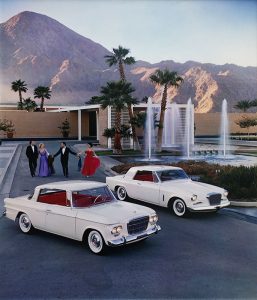
Grapes Lost and Found
In a recent conversation I had with Billy Al Bengston, he quoted his racing buddy: “If it only costs money, it’s cheap.” Being an avid collector myself (although not of Contemporary Art) my interpretation of his words is: It can take a lot of effort, time and money to track down a specific object. Sometimes it can take years and money can’t help.
We had an exhibition of large Lüpertz paintings from 1967-70 at Art Basel in 2005. The paintings were huge. The show looked stunning and was a great success. The painting “Weintrauben” did not find a place in the show of tree trunks, telegraph poles and tunnels and remained upstairs in storage to return with the other works to Germany after the fair. But it never arrived. We only realised it had gone missing about a year later when a loan request for the work came and we couldn’t locate it.
Now 15 years later a friend sends me this cryptic text message: “Dear Daniel, tell me, are you missing a grape painting? I hope you are well. Best wishes…”
It turns out that the crate with our label still on it mysteriously turned up in a private furniture warehouse in Munich. The owner of that warehouse is a friend of our friend. I thought “Great! The grapes are back.” But then the finder emailed: “How can I be sure you are the owner? I think I’d better go to the police.” Days of silence followed. The painting had vanished again. Then somebody within the city’s Lost and Found department called up. He had been referred to us by the Lenbachhaus, and wondered if we dealt in Lüpertz? “There is this painting someone found…”
I am sure that many of the artworks we enjoy today would have fascinating stories to tell, if only they could speak to us in words as well as with their beauty. I thought this lucky moment merited a presentation on the theme of flora and colour.
Karl-Heinz Schwind was our first exhibition when we opened some 30 years ago. His works are pure energy.
Eugène Leroy, who sometimes worked for several years on a painting before considering it finished, Don van Vliet, cult musician and painter and Billy Al Bengston, known for his tropical themes and vivid colors, are well known and do not need my introduction.
David Byrd is neither “Insider” nor “Outsider”. Having studied art after WWII under Amédée Ozenfant he only developed his mature style and produced his most defining body of work after he started working as an orderly at a hospital psychiatric ward, from 1958-88.
His paintings defy any of the “Isms” we usually like to apply to art we see; they stand apart from Pop, Realism or Expressionism. If anything I would refer to his work as New York Surrealism. Byrd’s works have an airy and somewhat evanescent quality, as if viewed through a milky glass.
Guerle and Nény were true self-taught artists who remained more or less in obscurity but whose visual languages are equally inspiring and distinctive as the better-known artists in our exhibition. They only came to my attention through writers like Hans Prinzhorn or Dr. Jean Lacassagne, who were interested in and propagated the artistic output of mentally insane or criminal individuals. Prinzhorn’s Bildnerei der Geisteskranken (Berlin 1922) and Albums du Crocodile by Lacassagne (Lyon 1939) have been rare sources of information on these fascinating artists.
Register for Online Viewing Room here
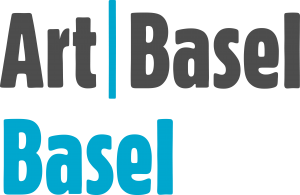





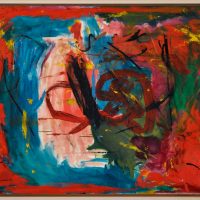


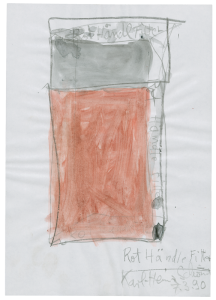
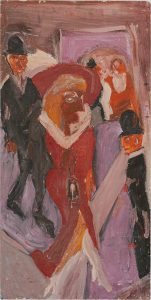
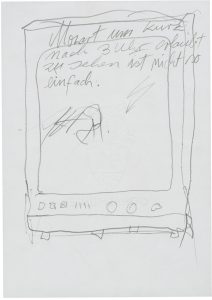
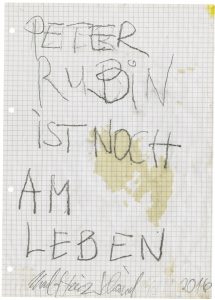
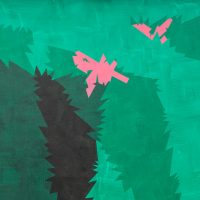
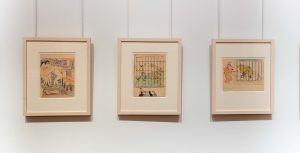
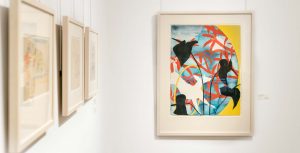
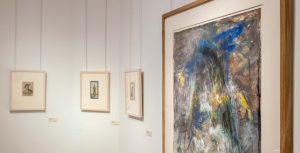

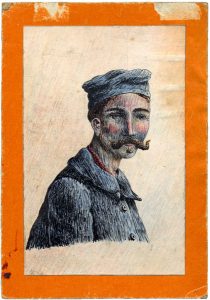


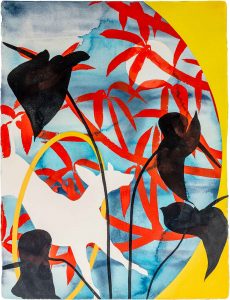
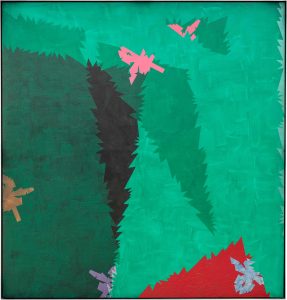
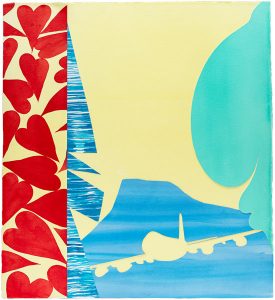

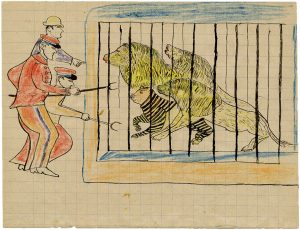
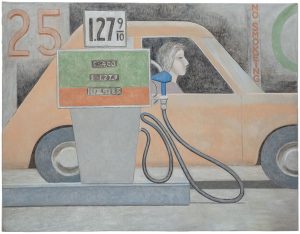

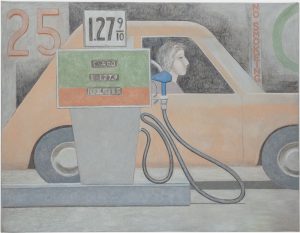
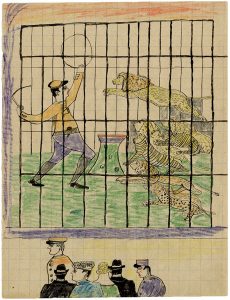

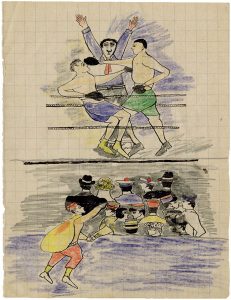
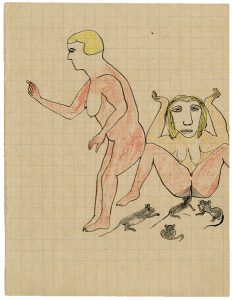
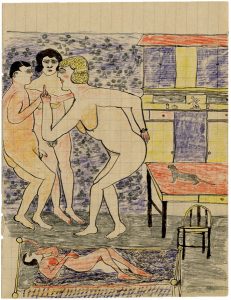

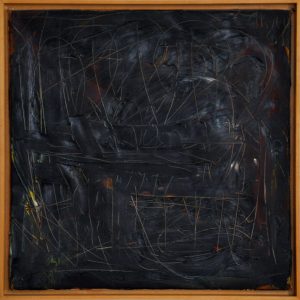

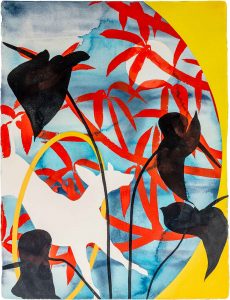
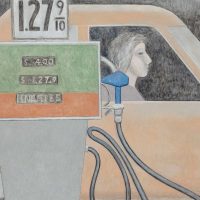
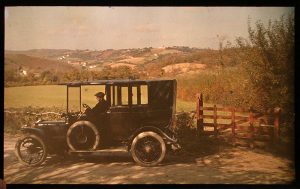

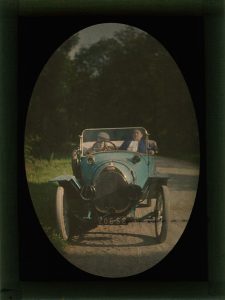
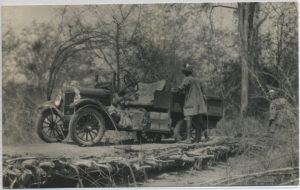
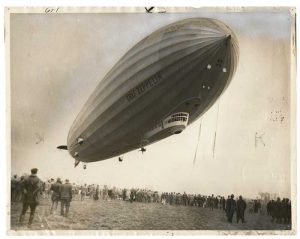
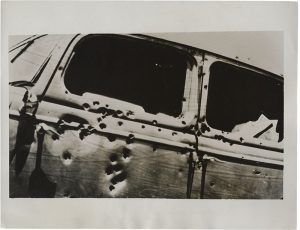

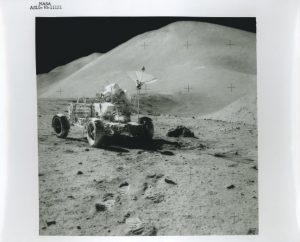


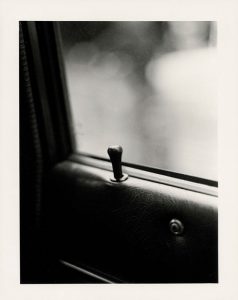
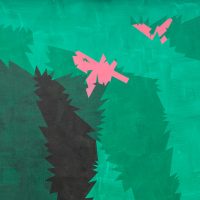
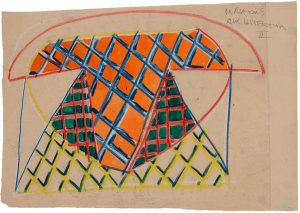


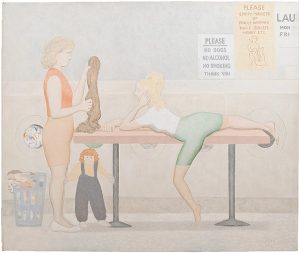
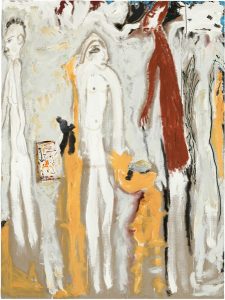

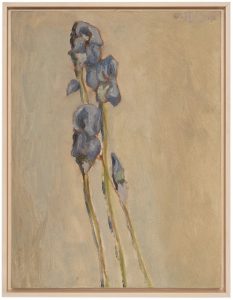
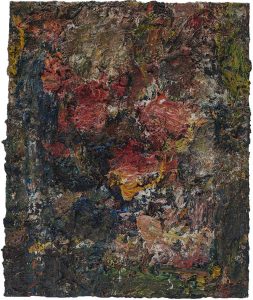

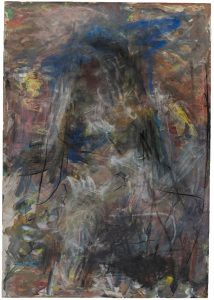
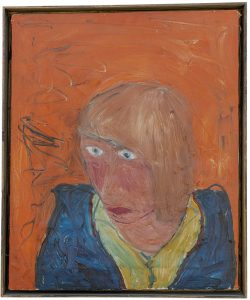
 +49 89 29 73 42
+49 89 29 73 42